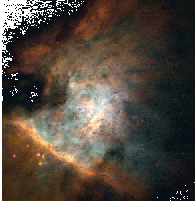 | Sputtering of Interstellar Dust Grains Dr Paul May and Dr David Field |
 | Sputtering of Interstellar Dust Grains Dr Paul May and Dr David Field |
Dust particles in the interstellar medium are composed mainly of silica (SiO2), magnesium and iron silicates (e.g. olivine, orthopyroxine, forsterite), amorphous carbon or water ice. The mechanism by which these particles are created and destroyed is of immense importance to the way dust material is dispersed around the galaxy. Since planetary bodies are created when enough of this dust coalesces, the rate of destruction of dust particles is important when considering whether planets will form in certain regions of space.
It is currently believed that these dust particles are destroyed by sputtering erosion, as they move at high velocities (tens of km per second) through regions of space containing ions that were created by stellar shock waves. For the purposes of calculating sputtering rates, this process is identical to high energy ion bombardment of a stationary target. Previous models for this sputtering rate used very crude approximations for the variation of sputter yield with ion impact energy and angle, and so estimates for the rate of destruction of these grains were highly suspect.
Recently in Bristol (in collaboration with Professor David Flower at Durham University and Gillaume Pineau des Forêts, Observatoire de Paris, Meudon, France), we have been working on a much more accurate model for this sputtering rate, using a program called TRIM (TRansport of Ions in Matter). This program uses a Monte Carlo approach to follow the trajectory of individual ions as they strike a target and produce cascades of knock-on atoms, some of which pass back out through the target surface and are counted as sputtered. The program was originally written to calculate ion damage and implantation effects in the nuclear industry, but has also been successfully used to simulate reactive ion etching in semiconductors.
The values for sputtering yields calculated in this way are producing numbers which agree much more closely with those predicted from astronomical observations than previous yield values did. We are presently performing calculations for various of the different materials which make up interstellar grains to determine the relative importance of the different destruction mechanisms.


 Back to
Physical Chemistry Home page, or Bristol University Chemistry Dept Home Page.
Back to
Physical Chemistry Home page, or Bristol University Chemistry Dept Home Page.
. Paul May